Weirs have played a key role in the history of Marple and Mellor, providing a reliable source of power to the early mills and a steady flow of of water for washing to the mills engaged in bleaching and printing. We have already looked at the more modern weir built in Brabyns Park by the Environment Agency here; now we should look at the rather more historic weirs which have played an important role in our heritage.
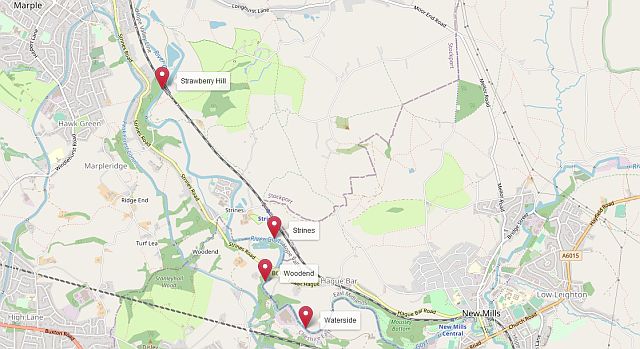
Stockport’s Historic Weir
[for the weir locations click the image or Open Street Map]
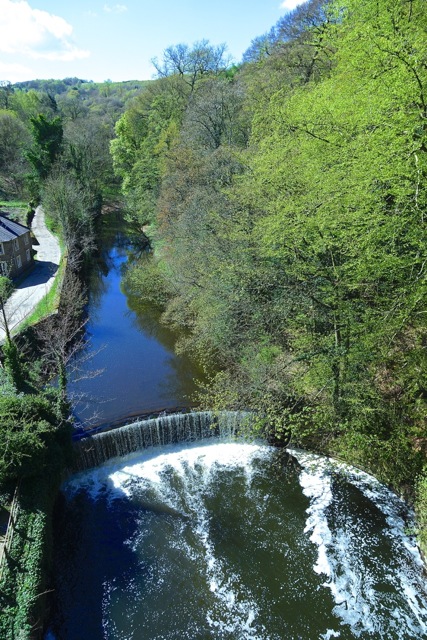 Strawberry Hill weirWeirs are a common feature worldwide as the technology is simple and there are many examples in the UK because of the early evolution of the industrial revolution in this country. The environment agency estimates that there are 16,725 on major rivers in England and Wales alone though this figure ignores the many small weirs on feeder streams such as Mellor Brook or Mill Brook. There are at least 18 weirs within the boundaries of Stockport MBC along the Goyt, the Tame and the Mersey. For the purposes of this article we shall concentrate on those weirs on the Goyt as they are more relevant to this area, though the others will be given an honourable mention.
Strawberry Hill weirWeirs are a common feature worldwide as the technology is simple and there are many examples in the UK because of the early evolution of the industrial revolution in this country. The environment agency estimates that there are 16,725 on major rivers in England and Wales alone though this figure ignores the many small weirs on feeder streams such as Mellor Brook or Mill Brook. There are at least 18 weirs within the boundaries of Stockport MBC along the Goyt, the Tame and the Mersey. For the purposes of this article we shall concentrate on those weirs on the Goyt as they are more relevant to this area, though the others will be given an honourable mention.
It is perhaps useful to examine the typical layout of a weir and the associated channels alongside a river which would provide power to a mill. A head of water is stored in a pond on the river, known as the dam, and this is created by the damming of the river by a weir. Water was usually intended to flow over the weir but there were often arrangements for the overflow of excess water, controlled by sluices or shuttles. From the dam (usually from one end of the weir) water was led into a leat, the head goit (aWeirlso controlled by shuttles), which carried it parallel to the river towards the mill; here the water would enter a small reservoir, the fore-bay, before being carried in an iron or wooden pentrough to the waterwheel itself. The most efficient design of wheel fed water at the top - an overshot wheel. However, the topography might necessitate water being introduced at a lower level, either half way (breast shot) or at the base (undershot). If these designs are used there is only a slight reduction in efficiency. After turning the wheel, the water would enter the tail goit to be returned to the river downstream of the mill.
Once the Goyt has passed through the Torrs in New Mills it creates a wide valley with extensive flood plains - eminently suitable for spreading out long lengths of cloth as required by bleach and dye works. All these works needed clean water so they had large settling ponds alongside the works, fed by water from weirs on the river. Three separate factories, all operating as printworks, were established within a short stretch of the river.
Waterside Weir SJ 98255 85239
The first of these was Waterside Mill, established in 1804. It had a difficult time from the first and by 1828 it was converted into a cotton spinning mill and eventually into a paper mill. Despite its rather varied history and changing ownership it is one of the few mills still working today, as Northwood Tissues. The weir no longer serves any purpose. photo
Woodend Weir SJ 97853 85708
A decade before Waterside Mill, land was leased from Peter Legh of Lyme at Woodend and the Woodend Printworks established. This too had a succession of owners until it came under the control of Strines Printworks in the 1870s and was used as an extension of the main factory but eventually demolished so only the settling ponds remain.
Strines SJ 97943 86133
What was to prove the most successful and longest lasting of all the printworks was established in 1792 although linen had been bleached in the immediate area for some period before this. The company saw several phases of expansion and took control of the Woodend mill in the 1870s.
Strawberry Hill SJ 96827 87622
This (above) was the key weir for Mellor Mill, diverting the water flow into the mill ponds, or Roman Lakes as they are now known. The weir is still in relatively good condition after 230 years, a tribute to the quality of the original workmanship. For modern purposes there is good access to the site but only the weir can be used to provide a head for hydro. Nevertheless there is a head of 2.7 m in moderate flow.
Marple Bridge SJ 96510 89350
Approximately 1 metre high, this weir was built to power the corn mill which stood on the west bank of the Goyt. The structure is degraded and the crest is no longer level so it would need considerable repairs to bring it back to working order. Access is both limited and difficult.
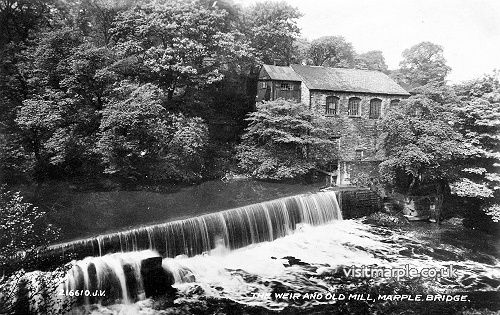
Brabyns Park SJ 96419 90046
Locally known as Wright’s Folly, this weir was completed to a very high standard by Nathaniel Wright, the owner of the Brabyns estate, in 1804. The local story is that Wright built the weir in order to power a factory he intended to build on the estate. However, once he had built it, he realised that it would be necessary to flood the estate in order to power a mill from it. It is a nice story but that is all it is - the real reason is much more interesting.
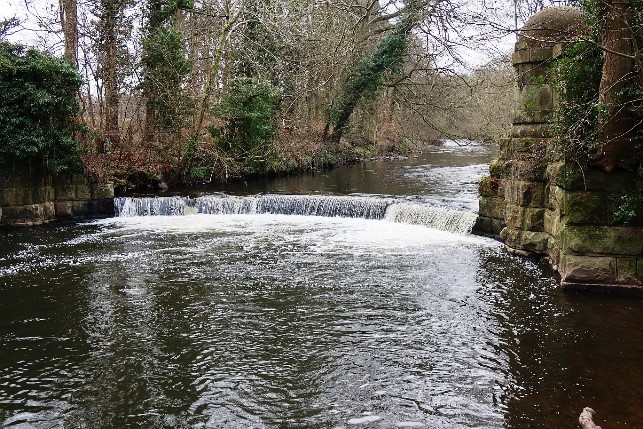 Wright was a self-made man from Crich in Derbyshire who had come to this area to manage Lord Warren’s mines in Poynton. Over time he gradually built up his mining interests in Bredbury, Denton and Hyde as well as Poynton and also had interests in lime kilns and canal wharves. He bought the Brabyns estate in 1800 and over the next decade made considerable improvements.
Wright was a self-made man from Crich in Derbyshire who had come to this area to manage Lord Warren’s mines in Poynton. Over time he gradually built up his mining interests in Bredbury, Denton and Hyde as well as Poynton and also had interests in lime kilns and canal wharves. He bought the Brabyns estate in 1800 and over the next decade made considerable improvements.
He set his sights on the burgeoning cotton industry and built the weir on the Goyt in anticipation of powering a mill. He agreed to sell this weir to Jesse Howard, a prominent Stockport mill owner, together with the right to return the water to the river further downstream, giving a fall of 23 feet. A total of three agreements were signed in 1809 and 1810 changing the price from an annual rental of £330 to a purchase price of £6600 (£530,000 in current value.)
However, Howard was beginning to have second thoughts when he investigated more deeply and found that Wright did not have the legal authority to do as he had promised - there were other landowners involved who also had water rights. Howard asked for his money back, Wright sued for non-compliance of contract and the dispute degenerated into an ongoing legal case. Wright died in 1818 but the case was only resolved in 1823, finding against Wright but refuting the suggestion of fraud.
We are left with an elegant weir with impressive masonry abutments that has never been used for its original purpose.
Compstall SJ 97342 91280
This is a very substantial weir, rivalling the Brinnington weir in overall size. It dams the Etherow, a tributary of the Goyt, in order to feed the mill ponds and power Compstall Mill. It was built in 1826 by George Andrew and served its purpose for well over a century. Somewhat surprisingly Stockport MBC have not looked at the possibility of using this for generating hydro power; perhaps because of ownership issues.
Chadkirk SJ 94139 89881
This weir was built to provide a supply of water to the Chadkirk dye works. It was badly breached during floods a generation ago but the offtake can still be seen slightly upstream on the Romiley bank. It was built by the Siddalls for their works as they leased the land from Lady MacDougal who owned much of the immediate area. The weir is now largely destroyed and it wasn’t helped when the Sustrans Bridge was erected on almost exactly the same site. Close by, and about 100 metres downstream of the weir, is the ford which was a popular route between Romiley and Marple.
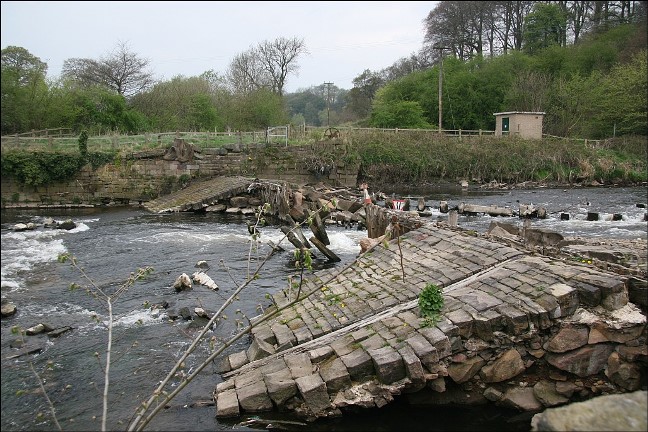
Chadkirk Weir in 2009 [ click image to river in full flow]
Interestingly the minutes book of Marple UDC for 1936 reports several approaches from Bredbury and Romiley UDC about sharing the cost of a bridge at this point. Marple UDC did its best to ignore the approach but in the end met with representatives from Bredbury & Romiley. It was to no avail. Marple informed them that “this Council cannot see that the proposed bridge would be of sufficient benefit to Marple to warrant the cost.”
Otterspool SJ 93648 89433
Just like Brabyns, this weir was built but never used. Once again the Stockport mill owner, Jesse Howard was involved. In the early nineteenth century he was engaged in fierce competition with Peter Marsland, another mill owner. They both had mills in the lower reaches of the Goyt and both abstracted water to power their mills. On two occasions, each erected a mill upstream of their rival, thus depriving them of the power they had planned for. In 1825 Howard bought a considerable portion of the Arderne estates in Bredbury and on this land planned to build a great mill race which would bypass Peter Marsland’s latest factory.
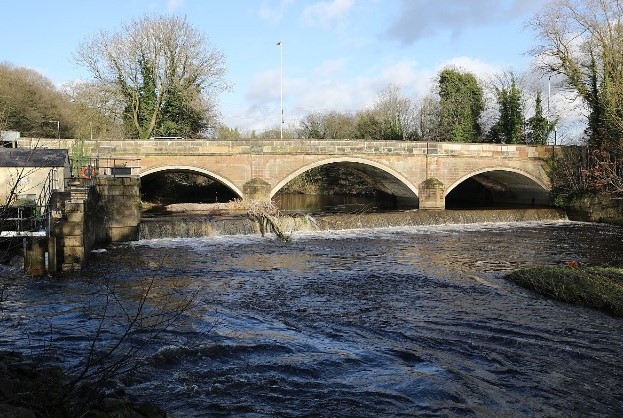 The weir at Otterspool was the first part of this planned mill race but the dispute between the two men over water rights was referred to the lawyers and any further construction was put on hold. The matter was finally settled in 1833 when Jesse Howard was awarded a share in the water supply Peter Marsland had constructed. In return Howard abandoned his own ambitious plan. Who would have thought that almost 200 years later the weir would be brought back into use with Stockport’s first hydro generation. The site was ideal for installing an Archimedean screw and this was done in 2012.
The weir at Otterspool was the first part of this planned mill race but the dispute between the two men over water rights was referred to the lawyers and any further construction was put on hold. The matter was finally settled in 1833 when Jesse Howard was awarded a share in the water supply Peter Marsland had constructed. In return Howard abandoned his own ambitious plan. Who would have thought that almost 200 years later the weir would be brought back into use with Stockport’s first hydro generation. The site was ideal for installing an Archimedean screw and this was done in 2012.
Woodbank SJ 91666 90400
In the late eighteenth and early nineteenth century, water power was the source of fierce competition Adjacent to Woodbank Park, this was Nab weir, which fed water into a tunnel system supplying Peter Marsland’s mills. Built in 1810 it acted as an additional supply to an existing system.
Stringers SJ 90837 90633
This was a very early weir supplying a factory complex along New Bridge Lane owned by the Howard family. It was named after the factory manager. In the summer months the tunnel from this weir “drew every drop of water” from the Goyt. Even though the water was returned below New Bridge Lane it must have caused considerable opprobrium from other mill owners. In the current era it offers good potential for hydro generation as the weir has a height of 1.8m.
St Mary’s Way SJ 90382 90711
This weir, just upstream from where St Mary’s Way crosses the Goyt, was built to provide water power directly to the New Bridge Lane factories.
Asda SJ 89877 90611
This next weir, just upstream of Asda, fed directly into the Portwood reservoir which was built in 1808 by Peter Marsland on meadowland he had bought. This was linked, via a tunnel system, to mills on the other side of the river.
City Centre SJ 89700 90838
Stockport MBC describes this weir as ‘City Centre’ but this description is a little premature, to say the least. Stockport does not have a cathedral and so far, Her Majesty has not deigned to award it a charter. It is also completely inaccessible and therefore unsuitable for hydro use.
Castle Hill SJ 93070 92950
Located on the Tame which is the border between Stockport and Tameside, this is a large capacity weir which used to provide a head of water for a mill a long way down stream. In total, measuring the weir and the goit, there is a head of 6.2m but the goit, which is 700m in length, is in a dilapidated state. By itself, the weir provides a head of water of 2.4m.
Brinnington SJ 90621 91861
This is the largest weir in the borough an is a spectacular structure. Initially developed in 1796 for a mill near the Tesco superstore. The goit that it originally fed has disappeared. Access is better on the south bank but a hydro station on the north bank would be a cheaper site to develop. The head is 4.7 m in moderate flow. Apparently the Tame has lower water quality than the Goyt so the latter river is given priority for fish migration investment within the Mersey basin, along with the Bollin.
Confluence SJ 89692 90854
This isn’t a weir but a confluence - where the Tame meets the Goyt. From hereon the combined river is officially the Mersey though until the eighteenth century the Mersey began at the confluence of the Goyt and the Etherow. The Mersey was the traditional boundary between Mercia and Northumbria.
Mersey Square SJ 89224 90300
To the west of the town centre, by the 1790s there were five new water-powered mills along the Mersey as far as Brinksway. Next to these factories their owners built weirs across the river, to build up a sufficient head of water to turn their water wheels.
Chestergate SJ 88871 90255
Brinksway SJ 88375 89972
Near the Co-op pyramid. The origin not known but it is thought to supply dye works rather than power application. In general terms weirs need to be at least one metre high in order to work efficiently. The height of this weir is estimated as 50 cms so it is probably not viable for hydro.
Vale Road SJ 86794 89999
A weir supplying the dye works originally owned by Samuel Oldknow and managed by his brother.

